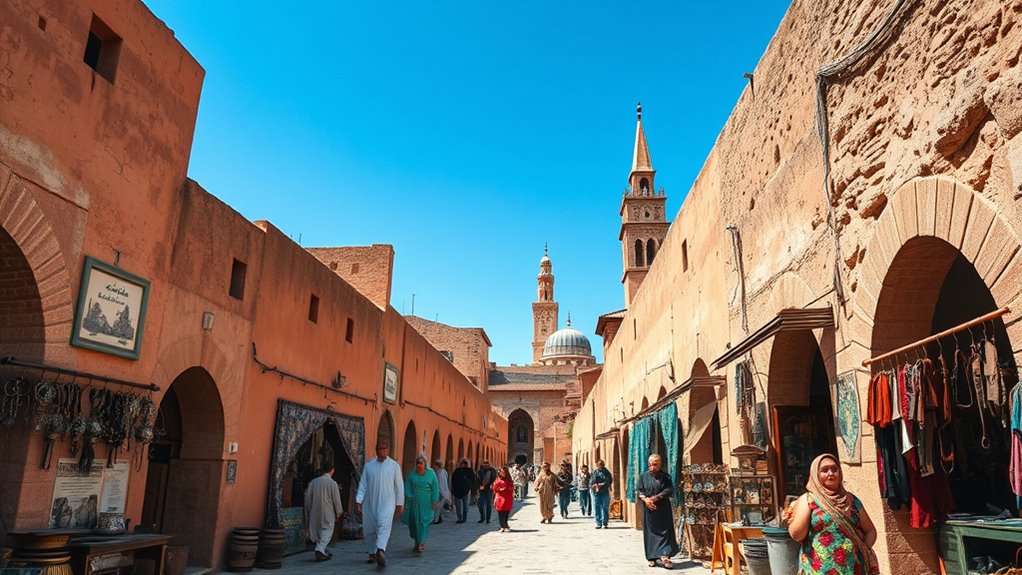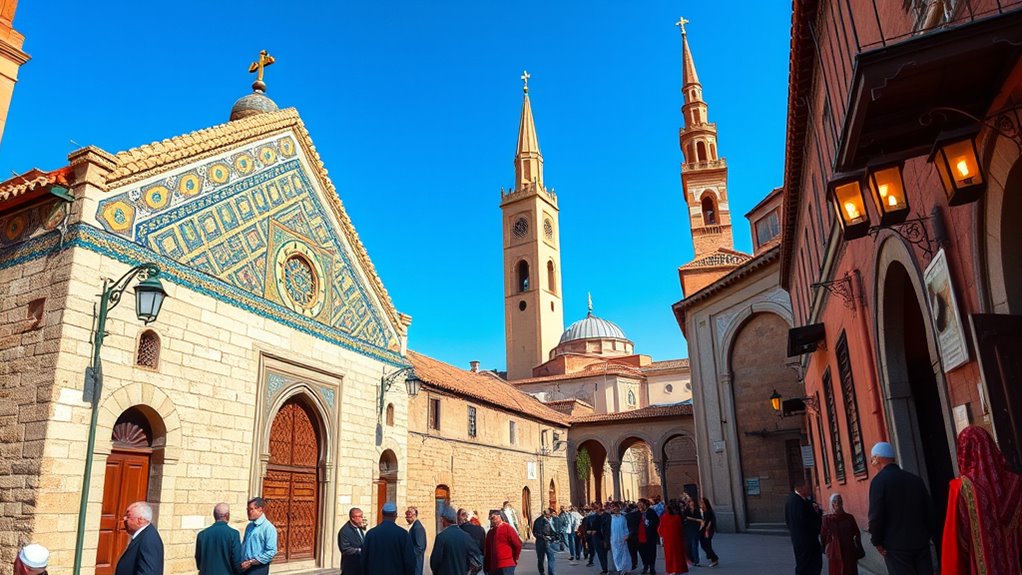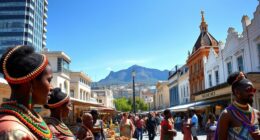Morocco’s history and culture are shaped by its Berber, Arab, and Islamic roots, dating back to the early Islamic conquests and dynasties like the Idrisids, Almoravids, and Almohads. You’ll find a vibrant blend of architecture, language, and traditions influenced by centuries of dynastic changes, colonization, and modern reforms. Its religious heritage reflects Islamic and Jewish coexistence, while its craftsmanship and landmarks showcase a rich legacy of artistic expression. Exploring more reveals how these elements continue to define Morocco today.
Key Takeaways
- Morocco’s history is shaped by early Islamic conquests, Berber resilience, dynastic empires, and colonial influences leading to independence in 1956.
- Fes, founded by Idris I, became a cultural and religious hub, reflecting Arab, Berber, and Islamic architectural and scholarly traditions.
- Architectural heritage features Islamic landmarks like Koutoubia Mosque and Marinid madrasas, alongside Berber kasbahs and ksars.
- Morocco’s diverse culture blends Arab, Berber, and Andalusian influences, with multilingualism in Arabic, Berber, and French enriching its identity.
- The nation’s heritage emphasizes resilience, mutual influence, and cultural diversity, evident in its historic sites, traditional crafts, and spiritual practices.
Early Islamic and Berber Foundations

The early Islamic and Berber foundations of Morocco set the stage for its rich cultural and political history. When the Muslim conquest of the Maghreb completed around 709, Islam and Arabic culture spread across Morocco. Berber tribes embraced Islam but kept their traditional laws and paid tribute to Muslim rulers. The Berber Revolt (740–743) led to independence, forming states like Berghwata and Sijilmassa. Meanwhile, the Kingdom of Nekor, established in 710, became Morocco’s first Muslim state under Umayyad influence. Over time, Berber groups developed unique Islamic practices, some blending local traditions with new faiths, creating diverse religious expressions across the region. These early foundations established a complex tapestry of indigenous Berber culture intertwined with Islamic civilization. Furthermore, the integration of Berber customs with Islamic traditions contributed to the distinct cultural identity that persists in Morocco today.
The Rise of the Idrisid Dynasty and Fes as a Cultural Hub

Amidst the evolving landscape of early Islamic Morocco, Idris I emerged as a pivotal figure in unifying the region under a new dynasty. He fled Abbasid persecution and founded the Idrisid Dynasty in 788, establishing Fes as Morocco’s first imperial capital in 792. This move transformed Fes into a vibrant cultural and religious center. To understand its significance, consider:
- The spread of Islamic learning, attracting scholars and students from across North Africa.
- The establishment of mosques, schools, and markets that fostered economic growth.
- The development of a unique blend of Arab, Berber, and Islamic traditions that shaped Fes’s identity.
This foundation cemented Fes as a hub of culture, scholarship, and religious life, influencing Morocco for centuries to come.
Dynastic Changes: Almoravids and Almohads

Rise of the Almoravid and Almohad dynasties marked pivotal shifts in Morocco’s history, transforming the political and cultural landscape of the region. The Almoravids, a Berber-led movement, established Marrakech as their capital in 1062 and expanded their empire across North Africa and into Spain, promoting the Maliki Sunni school and fostering Jewish economic growth. In 1147, the Almohads, originating from the Masmouda Berber tribe, overthrew the Almoravids, extending their rule throughout the Maghreb and Andalusia. They built iconic architectural landmarks like the Giralda and Hassan Tower, symbolizing their influence. However, internal conflicts and external pressures led to their decline by 1267. These dynasties profoundly shaped Morocco’s religious, political, and cultural identity, leaving a lasting legacy, including the development of distinctive Moroccan architecture and art.
Colonial Encroachment and the Path to Independence

As European powers increased their influence in North Africa during the late 19th and early 20th centuries, Morocco faced mounting pressure from France and Spain to expand their control over its territory. You should know that Morocco’s strategic location and resources made it a prime target. The 1880 Madrid Conference initially guaranteed Moroccan independence, yet France’s influence grew, leading to increased encroachment. By 1912, the Treaty of Fez officially established the French protectorate, while Spain gained control over northern regions. Key points include:
- France consolidates power through administrative restructuring and economic exploitation.
- Spanish control extends over the northern Rif and parts of the south.
- Moroccan resistance, led by nationalist movements, intensifies, setting the stage for independence.
- Self Watering Plant Pots exemplify innovative solutions for consistent moisture, which can symbolize the ongoing efforts for sustainable development and resilience in Moroccan society.
Modern Political Evolution and the Role of the Monarchy

Morocco’s modern political evolution has been deeply shaped by the enduring influence of the monarchy, which remains a central institution in the country’s governance. You see, since independence in 1956, the monarchy has maintained a unique balance of power, blending traditional authority with modern state functions. King Mohammed V laid the foundation for a constitutional monarchy, while his son, Hassan II, strengthened the monarchy’s political role through reforms and strategic diplomacy, like the Green March in 1975. Today, King Mohammed VI continues this legacy, implementing reforms to modernize institutions, promote economic development, and address social issues. Despite parliamentary elections and government institutions, the king holds significant executive and legislative influence, ensuring the monarchy’s central role persists in Morocco’s political landscape. Understanding the role of the monarchy has been crucial in grasping the country’s political stability and ongoing reforms.
Religious Heritage and the Interwoven Jewish and Islamic Traditions

Morocco’s religious landscape blends Islamic and Jewish traditions, creating unique syncretic practices that reflect centuries of coexistence. You’ll see this interwoven heritage in local rituals, architecture, and community life that honor both faiths. Jewish contributions have profoundly shaped Morocco’s culture, economy, and history, enriching its diverse spiritual fabric. The religious coexistence in Morocco is further exemplified by shared festivals and collaborative community projects that emphasize mutual respect.
Syncretic Religious Practices
In Morocco, religious practices often blend Islamic traditions with indigenous Berber customs and Jewish influences, creating a rich tapestry of syncretic beliefs. You’ll notice this in local rituals, festivals, and spiritual sites that weave together diverse traditions. Here are three key examples:
- Shared Sacred Spaces – Mosques and synagogues often coexist near each other, reflecting mutual respect and intertwined histories.
- Festivals and Celebrations – Events like the moussem and Jewish pilgrimages incorporate Islamic prayers with Berber rituals and Jewish prayers, emphasizing cultural harmony.
- Spiritual Practices – Many Moroccans blend Islamic Sufi rituals with Berber shamanic traditions, creating unique healing ceremonies and spiritual observances.
This syncretism showcases Morocco’s ability to unify diverse spiritual heritages into a cohesive cultural identity.
Jewish Contributions to Culture
Have you ever wondered how Jewish communities have shaped Morocco’s cultural fabric? They’ve played a crucial role throughout history, especially during the Idrisid and Almoravid periods. Jewish families contributed markedly to commerce, scholarship, and craftsmanship, enriching Moroccan society. In cities like Fez and Marrakech, Jewish artisans crafted intricate textiles, metalwork, and manuscripts, blending their traditions with Islamic art. Religious heritage is also evident in historic synagogues, cemeteries, and neighborhoods that coexist harmoniously with mosques and madrasas. Many Jewish scholars and merchants helped bridge cultural exchanges between Morocco and Spain, influencing language, music, and cuisine. The influence of cultural diversity is evident in the multifaceted heritage that continues to define Morocco’s identity today. Today, this interwoven heritage continues to shape Morocco’s identity, highlighting a shared history rooted in resilience, mutual influence, and cultural diversity.
Architectural and Linguistic Heritage of Morocco

You’ll notice Morocco’s rich architectural heritage in landmarks like the Koutoubia Mosque and Hassan Tower, which showcase Islamic artistry. The country’s Berber styles also stand out, with distinctive shapes and decorations in mountain villages and ancient fortresses. Additionally, Morocco’s multilingual culture, blending Arabic and Berber languages, highlights its diverse and layered history. The use of traditional building techniques and indigenous materials further emphasizes the country’s commitment to preserving its cultural identity.
Iconic Islamic Landmarks
Morocco’s iconic Islamic landmarks showcase a stunning blend of architectural ingenuity and cultural heritage that reflects centuries of religious and artistic evolution. You’ll find remarkable structures such as:
- The Koutoubia Mosque in Marrakech, renowned for its towering minaret and exquisite craftsmanship.
- The Hassan Tower in Rabat, an unfinished minaret that symbolizes Morocco’s historical ambition.
- The Bou Inania Madrasa in Fes, a prime example of Marinid architecture with intricate tilework and carved wood.
These sites embody Morocco’s Islamic history, blending Berber influences with Andalusian artistry. Their design features geometric patterns, decorative calligraphy, and harmonious proportions, revealing a rich tradition of craftsmanship. They continue to inspire, representing Morocco’s spiritual and cultural identity.
Berber Architectural Styles
Berber architectural styles showcase a distinctive blend of functional design and artistic expression rooted in Morocco’s indigenous heritage. You’ll notice their use of locally sourced materials like adobe, stone, and wood, which help keep structures cool in the desert heat. Buildings often feature flat roofs, thick walls, and small windows, emphasizing practicality and insulation. Artistic details are common, including intricate carvings, colorful tilework, and geometric patterns that reflect Berber symbolism. You’ll also find kasbahs—fortified homes—and ksars, traditional villages built around communal spaces. These structures are often nestled into the landscape, blending seamlessly with their environment. Berber architecture isn’t just about function; it’s a visual language that expresses cultural identity, history, and connection to the land. Additionally, many of these structures incorporate elements designed for climate adaptation, ensuring durability and comfort in the region’s extreme weather conditions.
Multilingual Heritage Significance
Architectural and linguistic heritage in Morocco reflect a rich tapestry of cultural influences that have shaped the nation’s identity over centuries. Your experience reveals a vibrant multilingual environment where languages like Arabic, Berber (Amazigh), and French coexist, each carrying historical significance. Consider these key aspects:
- The coexistence of Arabic and Berber as official languages, preserving indigenous traditions.
- The use of French in administration, education, and media, a legacy of colonial influence.
- Architectural features, such as intricate tilework and ornate calligraphy, that blend Arab-Islamic design with Berber motifs.
- Extensive research supports the significance of these cultural elements in understanding Morocco’s multilingual heritage.
This multilingual heritage fosters a unique cultural landscape, where language and architecture intertwine, celebrating Morocco’s diverse historical roots. It’s a living testament to the country’s ability to preserve tradition while embracing modernity.
Frequently Asked Questions
How Did Berber Traditions Influence Moroccan Islamic Practices?
You’ll notice that Berber traditions deeply influence Moroccan Islamic practices by blending indigenous customs with religious rituals. Berbers often retain traditional ceremonies, music, and clothing alongside Islamic practices, creating a unique cultural fusion. You might see syncretic religious rituals, local festivals honoring saints, and Berber languages used in religious contexts. This integration enriches Moroccan Islam, making it distinct with local customs that persist alongside mainstream Islamic beliefs and practices.
What Role Did Moroccan Cities Play in Medieval Trans-Saharan Trade?
You see Moroccan cities like Sijilmassa and Fes as essential hubs in medieval trans-Saharan trade. They served as key trading centers where merchants exchanged gold, salt, and other goods. These cities facilitated cultural exchanges and connected sub-Saharan Africa with North Africa and beyond. Their strategic locations helped Morocco become a wealthy and influential trading empire, shaping its history and fostering rich cultural interactions across regions.
How Did Moroccan Architecture Evolve Through Different Dynasties?
Your Moroccan architecture evolved markedly under different dynasties, reflecting cultural influences and religious traditions. During the Idrisid period, you see the emergence of intricate mosques and medinas. The Almoravid and Almohad eras introduced grand structures like the Koutoubia and Hassan Tower, showcasing Islamic artistry. Later, Moroccan architecture blended Islamic, Berber, and Andalusian styles, creating iconic palaces, mosques, and riads that continue to define the country’s visual identity today.
What Are the Origins of Morocco’s Amazigh Language Recognition?
You’ll find that Morocco’s Amazigh language gained official recognition through modern political efforts, especially after independence. The movement for Amazigh rights grew as Berber communities pushed for cultural preservation and linguistic equality. In 2011, Morocco’s constitution officially recognized Amazigh as an official language alongside Arabic, reflecting the government’s acknowledgment of Berber heritage. This change promotes linguistic diversity and cultural identity, helping Amazigh communities preserve their traditions and language in contemporary Moroccan society.
How Has Morocco Balanced Traditional Culture With Modern Reforms?
You see Morocco balances traditional culture with modern reforms by embracing its rich heritage while adopting progressive policies. You witness efforts to preserve Berber languages and customs, even as Arabic and French influence grow through education and business. You observe the government promoting cultural festivals, protecting historical sites, and implementing reforms that enhance women’s rights and economic development. This dynamic approach allows Morocco to honor its roots while progressing toward a modern, inclusive society.
Conclusion
As you explore Morocco’s mesmerizing mosaic of history and heritage, you’ll witness the weaving of wondrous wonders—winding through wild waves of war and peace. From fortified forts to flourishing faiths, the country’s rich roots reveal resilience and radiance. Embrace the enduring elegance of its architecture, language, and legends, and see how Morocco’s magnificent mosaic continues to mirror its majestic, multifaceted past—an everlasting emblem of its proud, persistent spirit.










